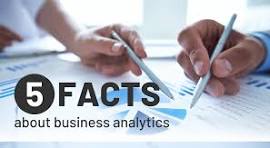-
“some interesting facts about business analytics”
“some interesting facts about business analytics” In the data-driven world of today, business analytics
- has become an important tool for companies that
- want to stay ahead of the competition. Not only does
- this field help with making smart decisions, it also finds hidden
insights that can help businesses grow. “some interesting facts about business analytics” Here are some interesting facts about business analytics that show how important and useful it is.
1. An industry worth $150 billion
The field of business analytics is growing quickly and isn’t just a trendy word. The market for business analytics is thought to be worth more than $150 billion, according to new projections. This rise is being driven by the need for more data-driven decisions in many fields, such as retail, technology, healthcare, and finance.Companies are putting a lot of money into analytics tools and services to get the most out of their data.
2. Data explosion: more than 2.5 bytes every day
About 2.5 bytes of data are created every day. Businesses have to sort through a huge amount of information, as this huge amount shows. Business analytics tools help companies handle and understand this data so they can make smart choices quickly and correctly. Without these tools, it would be very hard to manage and get useful information from such a huge amount of data.
Predictive analytics: Making plans for the future
A type of business analytics called predictive analytics uses statistical tools and machine learning to figure out how likely it is that something will happen in the future based on data from the past. Businesses use predictive analytics to guess how customers will act, make processes run more smoothly, and lower risks. For instance, stores use predictive analytics to figure out how much inventory they will need in the future, and financial institutions use it to check credit and find fraud.

4. How Real-Time Analytics Are Helping Businesses
The power to look at data in real time is changing the way businesses work. With real-time analytics, businesses can keep an eye on events and act on them as they happen, instead of waiting for reports based on old data. This feature is especially useful in fields like banking and e-commerce, where quick insights can help make decisions and make the customer experience better.

5. Businesses that are driven by data are 23 times more likely to get new customers.
Companies that use data are 23 times more likely to get new customers, 6 times more likely to keep old customers, and 19 times more likely to make money. The importance of business data in getting a competitive edge is shown by these numbers. Companies can change their plans to better meet customer wants and boost overall performance by using data insights.
6. Using AI and machine learning together
Machine learning and artificial intelligence (AI) are being added to business data tools more and more. With these technologies, it’s easier to look at big sets of data and find trends that aren’t obvious at first. Analytics platforms that use AI can automate routine chores, give you more information, and even make more accurate predictive models.
7. The Skill Gap: More and more people need data professionals
There aren’t enough skilled people in the area of business analytics, even though it’s growing quickly. Companies are actively looking for data workers who can make sense of large datasets and turn results into strategies that can be used. This need has caused a lot of new data analytics courses and certifications to pop up, which shows how important it is to keep learning in this ever-changing area.
“some interesting facts about business analytics”

8. The Power of Storytelling in Data
One of the most important parts of business analytics is being able to data well. Putting data into charts, graphs, and screens makes it easier to understand and more interesting to learn about complicated things. This helps people make better decisions and improves communication within organisations, so everyone can quickly and easily understand what’s going on.
9. Moral Issues and Privacy of Data
Data protection and moral issues are becoming more important as the use of business analytics grows. Companies have to deal with rules like to make sure they handle data properly. To keep customers’ trust and stay out of trouble with the law, businesses need to use data in an ethical way. This is why data governance is an important part of any analytics plan. “some interesting facts about business analytics”
10. The future: adding more data to analytics
Augmented analytics is about to change the field in a big way. AI, machine learning, and traditional analytics are all being used together in this new trend to automate the processes of data preparation, idea generation, and decision-making. Augmented analytics is supposed to make data analysis easier for people who aren’t tech-savvy, opening up data insights to people of all skill levels.
In today’s fast-paced and data-driven world, businesses are constantly on the lookout for ways to gain a competitive edge. Enter business analytics – the transformative tool that’s revolutionizing how companies operate and make decisions. But what exactly makes business analytics so intriguing and essential for modern enterprises? Let’s dive into the core reasons why business analytics is not just interesting but indispensable for businesses seeking to thrive in the digital age.
-
Data-Driven Decision Making
Gone are the days when decisions were based on gut feeling or historical norms. Business analytics empowers companies to make decisions grounded in data.This shift from intuition-based to data-driven decision-making ensures that strategies are more precise, reducing the risk of costly errors and enhancing overall operational efficiency.
-
Uncovering Hidden Insights
Business analytics tools excel at sifting through vast amounts of data to uncover hidden patterns and insights. These insights can reveal valuable information about customer behavior, market trends, and operational inefficiencies. For instance, analytics can help identify which products are likely to be successful in the future or which marketing strategies yield the best ROI. By revealing these hidden insights, business analytics enables companies to capitalize on opportunities and address challenges before they become significant issues.
-
Enhanced Customer Understanding
In the age of personalization, understanding your customers is crucial. Business analytics provides a deep dive into customer data, allowing companies to segment their audience effectively and tailor their offerings to meet specific needs. By analyzing customer preferences, behaviors, and feedback, businesses can create more targeted marketing campaigns, improve product development, and enhance customer satisfaction. This level of understanding helps build stronger customer relationships and fosters brand loyalty.
-
Optimizing Operations
Efficiency is key to maintaining a competitive edge, and business analytics plays a critical role in optimizing operations. Through process analysis and performance metrics, companies can identify bottlenecks, streamline workflows, and enhance productivity. Whether it’s managing inventory levels, optimizing supply chain logistics, or improving employee performance, business analytics provides actionable insights that lead to cost savings and operational improvements.
-
Forecasting and Trend Analysis
Predicting future trends and preparing for them is a major advantage of business analytics. By leveraging predictive analytics, businesses can forecast market trends, customer demands, and financial performance. This foresight allows companies to proactively adjust their strategies, allocate resources more effectively, and stay ahead of the competition. Forecasting also helps in risk management, enabling businesses to mitigate potential challenges before they impact operations.
-
Competitive Advantage
In a crowded marketplace, having a competitive advantage can be the difference between success and failure. Business analytics provides companies with the tools to analyze competitors, assess market conditions, and identify strategic opportunities. By understanding their position in the market and anticipating competitors’ moves, businesses can craft strategies that leverage their strengths and capitalize on market gaps.
-
Improving Financial Performance
Financial management is at the heart of any successful business, and analytics plays a pivotal role in enhancing financial performance. Through financial analytics, businesses can monitor key financial metrics, analyze cost structures, and optimize pricing strategies. This level of financial insight allows companies to make informed budgeting decisions, improve profitability, and ensure sustainable growth.
-
Encouraging Innovation
Innovation thrives on insights and data-driven experimentation. Business analytics fosters a culture of innovation by providing the data needed to test new ideas, evaluate their potential impact, and iterate on them. By leveraging analytics, businesses can make informed decisions about product development, market expansion, and other innovative initiatives, ensuring that new ventures are grounded in solid evidence and have a higher chance of success.
In the realm of technology and business, data analytics stands out as a dynamic and transformative field. It’s a domain that continually evolves, pushing the boundaries of what’s possible with data. But amidst the complexities and innovations, what is an intriguing fact about data analytics that captivates both experts and enthusiasts alike? Here’s a deep dive into one particularly fascinating aspect: how data analytics can predict human behavior with remarkable accuracy.
Predictive Power: Data Analytics and Human Behavior
One of the most compelling facts about data analytics is its ability to predict human behavior with astonishing precision.
The Magic of Predictive Analytics
Predictive analytics operates by analyzing patterns in historical data to make educated guesses about future events. For example, by examining past purchasing behavior, companies can predict what products customers are likely to buy next. Similarly, by analyzing social media interactions, predictive models can forecast trends and sentiment shifts.
What makes this fact particularly interesting is the breadth of applications:
Consumer Behavior:
Retailers and marketers use predictive analytics to tailor personalized recommendations, optimize marketing campaigns, and increase conversion rates. For instance, Netflix and Amazon rely on predictive models to suggest movies or products based on your past behavior and preferences.
Healthcare:
In the healthcare industry, predictive analytics helps in anticipating patient needs, optimizing treatment plans, and even predicting outbreaks of diseases. By analyzing patient data, healthcare providers can identify individuals at risk for certain conditions and intervene earlier.
Finance:
Financial institutions utilize predictive analytics to assess credit risk, detect fraudulent transactions, and forecast market trends. This helps in making informed lending decisions and managing financial risk more effectively.
Sports
Teams and coaches use data analytics to enhance player performance and strategize game plans. Predictive models can assess player statistics, game conditions, and opponent strategies to improve chances of success.
The Science Behind the Prediction
The ability to predict human behavior is rooted in the sophisticated algorithms and models used in data analytics. Machine learning techniques, such as regression analysis, decision trees, and neural networks, play a crucial role. These models are trained on large datasets to recognize patterns and correlations that might not be immediately apparent to human analysts.
For example
a recommendation engine on a streaming service might use collaborative filtering to analyze user behavior and preferences. By comparing your viewing habits with those of other users with similar tastes, the engine predicts what content you are likely to enjoy next.
Real-World Impact
The predictive power of data analytics is not just a theoretical concept; it has real-world implications that can significantly impact various industries. For businesses, it translates into more effective marketing strategies, improved customer experiences, and higher profitability. For individuals, it means more relevant product recommendations, personalized healthcare, and enhanced user experiences across various platforms.
Moreover, the ability to predict human behavior contributes to more proactive decision-making. Rather than reacting to trends and issues after they arise, organizations can anticipate and prepare for future scenarios, giving them a competitive edge.
In the modern business landscape, where data is often described as the new oil, Business Intelligence (BI) stands out as a critical tool for unlocking its value. Business Intelligence isn’t just a trend; it’s a transformative force reshaping how organizations operate and make decisions. But what exactly makes Business Intelligence so compelling and essential for today’s enterprises? Let’s delve into the captivating aspects of BI and uncover why it’s a game-changer for businesses.
-
Empowering Data-Driven Decision-Making
At the heart of Business Intelligence is its ability to turn raw data into actionable insights. BI tools aggregate and analyze data from various sources, presenting it in a comprehensible and visually appealing format. This empowers decision-makers with real-time information and predictive analytics, allowing them to make informed decisions rather than relying on gut feeling or outdated reports. The result? More strategic decisions that can significantly impact a company’s success and agility in a competitive market.
-
Real-Time Data Access and Reporting
One of the most exciting features of Business Intelligence is its capacity for real-time data access and reporting. BI platforms, however, provide live data feeds and up-to-the-minute reporting dashboards. This real-time access ensures that organizations can respond promptly to market changes, operational issues, and emerging opportunities, giving them a substantial advantage over competitors.
-
Enhanced Data Visualization
Data visualization is a cornerstone of Business Intelligence, transforming complex datasets into easy-to-understand charts, graphs, and dashboards. These visual tools make it easier for users to identify trends, patterns, and outliers. Interactive dashboards allow users to drill down into specific data points, customize their views, and gain deeper insights. Effective data visualization not only enhances understanding but also drives more informed decision-making across all levels of an organization.
-
Streamlined Operations and Efficiency
Business Intelligence contributes to operational efficiency by identifying inefficiencies and areas for improvement. Through data analysis, BI tools can pinpoint process bottlenecks, resource allocation issues, and performance gaps. This insight enables businesses to streamline operations, optimize workflows, and reduce costs. For example, BI can reveal supply chain inefficiencies, allowing companies to adjust inventory levels and reduce waste.
-
Predictive Analytics and Forecasting
An intriguing aspect of Business Intelligence is its integration with predictive analytics and forecasting. BI tools can analyze historical data and identify trends that help in predicting future outcomes. This capability allows businesses to anticipate market demands, optimize inventory, and plan strategic initiatives. By leveraging predictive models, companies can make proactive decisions and stay ahead of market shifts, enhancing their strategic planning and risk management.
-
Improved Customer Insights
Understanding customer behavior is crucial for crafting effective marketing strategies and improving customer satisfaction. Business Intelligence tools provide in-depth analysis of customer data, including purchasing patterns, preferences, and feedback. This customer insight enables businesses to personalize their offerings, tailor marketing campaigns, and enhance customer experiences. By leveraging BI, companies can build stronger customer relationships and drive brand loyalty.
-
Competitive Advantage
In a crowded marketplace, gaining a competitive edge is essential. Business Intelligence provides companies with the tools to analyze market trends, monitor competitor performance, and identify emerging opportunities. By harnessing BI insights, organizations can refine their strategies, capitalize on market gaps, and position themselves ahead of competitors. This competitive intelligence is invaluable for maintaining and growing market share.

-
Scalability and Adaptability
As businesses grow and evolve, their data needs become more complex. Business Intelligence systems are designed to scale with the organization, accommodating increased data volume and more sophisticated analytical requirements. Modern BI platforms offer flexibility and adaptability, allowing businesses to customize their solutions and integrate with other technologies as their needs change.
In the realm of data-driven decision-making, business analytics plays a crucial role in helping organizations understand their performance, anticipate future trends, and drive strategic initiatives. However, to leverage business analytics effectively, it’s important to understand the different types of analytics available. Each type serves a unique purpose and provides distinct insights into various aspects of a business. Let’s explore the five fundamental types of business analytics and how they can be used to enhance organizational success.
-
Descriptive Analytics: Understanding the Past
Descriptive analytics is the foundation of business analytics, focusing on summarizing historical data to provide insights into past performance. It answers the question, “What happened?” by analyzing data from various sources, such as sales reports, financial statements, and customer feedback.
Key Features:
Historical Data Analysis:
Looks at past data to identify trends, patterns, and anomalies.
Reporting and Dashboards:
Uses tools like charts, graphs, and summary reports to present data in a comprehensible manner.
Performance Tracking:
Measures key performance indicators (KPIs) to evaluate past success and areas for improvement.
Use Case:
A retail company uses descriptive analytics to review past sales data, identify which products performed well, and assess seasonal trends. This helps in understanding historical performance and setting benchmarks.
-
Diagnostic Analytics: Exploring the Reasons
While descriptive analytics focuses on what happened, diagnostic analytics delves into why it happened. This type of analytics investigates the causes behind past events by exploring correlations and patterns in data.
Key Features:
Root Cause Analysis:
Identifies the underlying factors contributing to specific outcomes.
Data Correlation:
Examines relationships between different variables to determine causation.
Drill-Down Reports: Allows users to explore data at various levels to uncover insights.
Use Case:
A company notices a sudden drop in customer satisfaction scores. Diagnostic analytics helps determine that the decline is linked to changes in customer service protocols, allowing the company to address the root cause.
-
Predictive Analytics: Forecasting the Future
Predictive analytics utilizes statistical models and machine learning techniques to forecast future outcomes based on historical data. It answers the question, “What could happen?” by identifying trends and making data-driven predictions.
Key Features:
Trend Analysis:
Uses historical data to identify trends and forecast future events.
Predictive Models:
Employs algorithms to estimate probabilities and outcomes.
Scenario Planning:
Helps in assessing potential future scenarios and their impacts.
Use Case:
A financial institution uses predictive analytics to forecast loan default risks based on historical borrower data and market conditions, allowing them to adjust lending strategies accordingly.
-
Prescriptive Analytics: Guiding the Way Forward
Prescriptive analytics goes a step beyond predicting future outcomes by recommending actions to achieve desired results. It answers the question, “What should we do?” by providing actionable insights and strategies.some interesting facts about business analytics
Key Features:
Decision Support:
Provides recommendations based on predictive analytics and scenario analysis.
Actionable Insights:
Offers practical steps to address challenges and capitalize on opportunities.
Use Case:
An e-commerce company uses prescriptive analytics to recommend inventory adjustments and marketing strategies based on predictive models, aiming to optimize sales and customer satisfaction.some interesting facts about business analytics
-
Cognitive Analytics: Enhancing Decision-Making with AI
Cognitive analytics is an advanced form of analytics that leverages artificial intelligence (AI) and natural language processing (NLP) to simulate human thought processes and enhance decision-making. Key Features:
Natural Language Processing:
Interprets and analyzes unstructured data such as text and voice.
Machine Learning:
Adapts and improves analytical models based on new data and feedback.
AI Integration:
Utilizes AI algorithms to provide deeper insights and automate decision-making processes.
Use Case:
A healthcare provider uses cognitive analytics to analyze patient records and unstructured data (like physician notes) to identify potential health risks and recommend personalized treatment plans.

